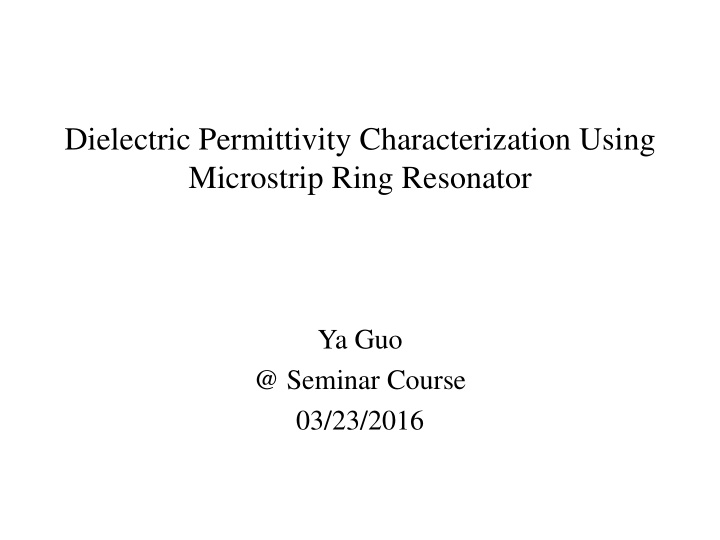



Dielectric Permittivity Characterization Using Microstrip Ring Resonator Ya Guo @ Seminar Course 03/23/2016
Contents 1. Introduction to mm-wave transmission line 2. Analysis and modeling of ring resonator 3. Dielectric permittivity characterization mechanism using resonator 4. Characterization of complex permittivity of dielectric fluids
Introduction to mm-wave transmission line (a) Coplanar waveguide (b) Microstrip line (c) Stripline (d) Rectangular waveguide
Introduction to mm-wave transmission line S Parameters: Scattering parameters can be used to define the characteristics of mm-wave transmission lines. b V b V 1 1 2 2 S S When a 1 =0: 12 22 a V a V S11 and S22 are Reflection Coefficients; 2 2 2 2 S12 and S21 are Transmission Coefficients. b V b V 2 2 1 1 S S When a 2 =0: 21 11 a V a V 1 1 1 1
Analysis and modeling of ring resonator Coupling Gap Feed lines The ring resonator is a T-line formed in a closed loop; The basic circuit consists of the feed lines, coupling gaps and the resonator; Power is coupled into and out of the resonator through feed lines and coupling gaps; The coupling gap should be large enough to form “weak/loose coupling”, meaning that the gap capacitance is negligibly small.
Analysis and modeling of ring resonator 1. Establish resonance: 2 r n g r : mean radius of the ring; : the guided wavelength; g n : the mode number. nc 2. The n th resonance occurs at: f n f 2 ( ) : nth resonant frequency; r f n eff c : light speed; : effective dielectric constant. eff 3. The effective dielectric constant at the nth resonance can be given by: 2 nc eff 2 rf n
Analysis and modeling of ring resonator For the Microstrip: 1 1 h w w 1 / 2 2 r r [( 1 12 ) 0 . 04 ( 1 ) ], 1 eff 2 2 w h h 1 1 h w 1 / 2 r r ( 1 12 ) , 1 eff 2 2 w h h: thickness of the substrate; W: width of the MSL. This can be used to characterize the dielectric substrate.
Analysis and modeling of ring resonator • example 1 -- set up a ring resonator working at 3*n GHz resonances: • Layout: • Results:
Analysis and modeling of ring resonator • Use HFSS for details verifications – Zoom in the fundamental resonant frequency and change the sizes of the coupling gaps.
Analysis and modeling of ring resonator • Extract QL; • Plot QL vs. Gap.
Dielectric permittivity characterization mechanism using resonator • Complex permittivity: * j Where the real component is related to the stored energy within the material, and the imaginary component is related to the energy loss within the material. * 0 r 12 8 . 854 10 F m 0 * tan where is the free space permittivity. 0
Dielectric permittivity characterization mechanism using resonator • Q-factor: High Q means low loss; Q is often difficult to calculate precisely. Measure it directly using S-parameters; Q u , Q L , and Q e : 1 1 1 Q Q Q L u e f n / f Q L is measured by at the 3dB; Q u is the desired parameters; Q e is related to the coupling.
Dielectric permittivity characterization mechanism using resonator • For the MSL resonator: 1 1 1 1 Q Q Q Q 0 c d r Where: Q 0 is the total Q-factor; Q c is the Q-value associated with the conductor loss; Q d is the Q-value associated with the dielectric loss; Q r is the Q-value associated with the radiation loss.
Characterization of complex permittivity of dielectric fluids • If the ring resonator is immerged in the dielectric fluids, what will happen?
Characterization of complex permittivity of dielectric fluids Resonator operates in dielectric fluids: 1. Resonant frequencies make shifts; 2. The insertion loss make changes. Characterize the complex permittivity of dielectric fluids: Measure the ring resonator in fluids; Use HFSS to provide simulated insertion loss to fit the measured insertion loss; Extract the relative permittivity and loss tangent of fluids.
Characterization of complex permittivity of dielectric fluids
Characterization of complex permittivity of dielectric fluids
Thanks! Any Questions?
Recommend
More recommend